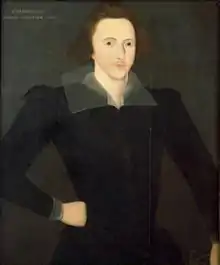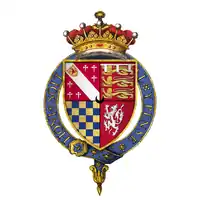Theophilus Howard, 2nd Earl of Suffolk
Theophilus Howard, 2nd Earl of Suffolk, KG (13 August 1584 – 3 June 1640) was an English nobleman and politician.
The Right Honourable The Earl of Suffolk | |
|---|---|
 The Earl of Suffolk | |
| Born | 13 August 1584 Saffron Waldon, Essex, England |
| Died | 3 June 1640 (aged 55) Charing Cross, London, England |
| Burial place | St Mary the Virgin, Saffron Walden, Essex, England |
| Occupation | English Earl |
| Spouse(s) | Lady Elizabeth Home |
| Children | James Howard, 3rd Earl of Suffolk Thomas Howard Katherine Stuart, Viscountess of Newburgh Elizabeth Percy, Countess of Northumberland Margaret Boyle, Countess of Orrery George Howard, 4th Earl of Suffolk Henry Howard, 5th Earl of Suffolk Anne Walsingham Frances Villiers |
| Parent(s) | Thomas Howard, 1st Earl of Suffolk Catherine Knyvet |

Born at the family estate of Saffron Walden, he was the son of Thomas Howard, 1st Earl of Suffolk, by his second wife, Catherine Knyvet of Charlton, and succeeded his father as 2nd Earl of Suffolk and 2nd Baron Howard de Walden in 1626, along with some other of his father's offices, including the lord-lieutenancy of the counties of Suffolk, Cambridge and Dorset.[1]
On 9 February 1608 he performed in the masque The Hue and Cry After Cupid at Whitehall Palace as a sign of the zodiac, to celebrate the wedding of John Ramsay, Viscount Haddington to Elizabeth Radclyffe .[2]
Sir Theophilus Howard was named in the Second Charter of Virginia made by King James I on 23 May 1609. The members of this extensive list were "incorporated by the name of The Tresorer and Companie of Adventurers and Planters of the Citty of London for the Firste Collonie in Virginia."
He was elected MP for Maldon in a by-election in 1605 caused by the death of Sir Edward Lewknor and sat until he was ennobled in 1610 as Baron Howard de Walden by a Writ of Acceleration.[3]
He was the dedicatee of Shelton's translation of Don Quixote, the first translation of the work in any language. The translation of the first part of Don Quixote was published in London in 1612, while Cervantes was still alive. It is not known why Shelton chose Howard as dedicatee, although he was possibly a distant relative.[4] He was also the dedicatee of John Dowland's last book of songs "A Pilgrimes Solace", also published in 1612.[5]
Howard visited Scotland in 1613. He dined with his brother-in-law James Home of Cowdenknowes at Broxmouth House, and then stayed in John Killoch's house in Edinburgh's Canongate, where the Duke of Lennox had stayed in 1608. He visited Dunfermline Palace and saw the coal-works of George Bruce at Culross. After a visit to Stirling Castle he stayed a night at the Nether Palace or Castlestead of Falkland with Lord Scone, and returned by boat to Leith and the King's Wark, the home of Bernard Lindsay. He went to Seton Palace to see Anne Hay, Countess of Winton, and then returned to England.[6]
Howard owned Framlingham Castle in Suffolk which he sold to Sir Robert Hitcham in 1635 for the sum of £14,000.
He died at Suffolk House, Charing Cross, London, and was buried on 10 June that year in Saffron Walden.
Marriage and children
In March 1612, he married Elizabeth Home (died 19 August 1633), daughter of George Home, 1st Earl of Dunbar. They had nine children:
- James Howard, 3rd Earl of Suffolk (c. 1620 – 1689)
- Thomas Howard
- Katherine Howard (died 1650), married first George Stewart, 9th Seigneur d'Aubigny (died 1642), second James Livingston, 1st Earl of Newburgh[7]
- Elizabeth Howard (died 11 March 1705), married on 1 October 1642 Algernon Percy, 10th Earl of Northumberland
- Margaret Howard, married Roger Boyle, 1st Earl of Orrery
- George Howard, 4th Earl of Suffolk (1625–1691)
- Henry Howard, 5th Earl of Suffolk (1627–1709)
- Anne Howard, married Thomas Walsingham
- Frances Howard (d. October 1677), married Sir Edward Villiers (died 1689)
References
- Chisholm, Hugh, ed. (1911). . Encyclopædia Britannica. 26 (11th ed.). Cambridge University Press. pp. 26–27.
- Edmund Lodge, Illustrations of British History, vol. 3 (London, 1838), p. 223.
- "HOWARD, Theophilus, Lord Howard de Walden (1584-1640), of Audley End, Essex and Suffolk House, The Strand, Westminster". History of Parliament Online. Retrieved 18 April 2014.
- Kelly, L. G.. "Shelton, Thomas (fl. 1598–1629)." L. G. Kelly in Oxford Dictionary of National Biography, edited by H. C. G. Matthew and Brian Harrison. Oxford: OUP, 2004. Online ed., edited by Lawrence Goldman, January 2008. http://www.oxforddnb.com/view/article/25318 (accessed 24 November 2014, subscription or UK public library membership required).
- "Image: ToLordWalden.jpg, (600 × 801 px)". culturebase.org. Retrieved 3 September 2015.
- Robert Chambers, Domestic Annals of Scotland, vol. 1 (Edinburgh, 1858), pp. 450-1.
- "Stuart [née Howard], Katherine, Lady Aubigny [other married name Katherine Livingston, Viscountess Newburgh] (d. 1650), conspirator - Oxford Dictionary of National Biography". oxforddnb.com. doi:10.1093/ref:odnb/66716. Retrieved 24 August 2019.
- "Howard pedigree 6". Retrieved 31 December 2006.
- . Dictionary of National Biography. London: Smith, Elder & Co. 1885–1900.
- Charles Mosley (ed.), Burke's Peerage, Baronetage & Knightage, 107th Edition, Wilmington, Delaware, 2003, vol III, pp. 3814–3817, ISBN 0-9711966-2-1